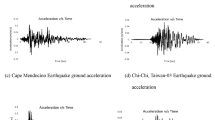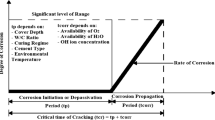Abstract
Corrosion of reinforcement in mechanically stabilized earth (MSE) walls is mainly due to physical and chemical properties of back-fill materials, types of metal reinforcement, and environmental factors. Therefore, it is imperative to evaluate the corrosion levels of reinforcement in the design and construction of MSE walls. This study employed artificial neural networks (ANN) to build prediction models of corrosion of reinforcement (COR) based on collected corrosion factors from 489 in-situ boring samples of MSE walls on highways in France. The ANN models were built, trained and achieved the best performance at an ANN structure (12-20-18-1) with one input layer (12 neurons), two hidden layers (20 and 18 neurons) and one output layer (1 neuron). The results have shown that the proposed model can provide a high coefficient correlation (R = 0.878) and a low mean squared error (MSE = 0.00454 µm2). Furthermore, a sensitivity study has shown that the factors of sulfate ion (SO42−), humidity, and time were the most important variables which influenced COR values. The research work could contribute significantly to geotechnical engineering with an optimal ANN model to predict the COR values of reinforcement metal in MSE walls.








Similar content being viewed by others
Explore related subjects
Discover the latest articles and news from researchers in related subjects, suggested using machine learning.Data availability
All data, models, or codes that support the findings of this study are available from the corresponding author upon reasonable request.
Abbreviations
- ANN:
-
Artificial neural network
- COR:
-
Corrosion of reinforcement
- MSE walls:
-
Mechanically stabilized earth walls
- R :
-
Coefficient of correlation
- MSE:
-
Mean squared error
- RMSE:
-
Root mean squared error
- R 2 :
-
Coefficient of determination
- w :
-
Weight
- θ :
-
Bias
- W :
-
Humidity
- R es :
-
Resistivity
- b :
-
Average width
- E 0 :
-
Average thickness
- N :
-
Tensile strength
- F :
-
Tensile force of reinforcement
- ε :
-
Elongation
- E zn :
-
Zinc thickness
- t :
-
Time
References
Hai DH (2012) Design and construction of reinforced earth walls. Vietnam Construction Publishing House Limited Company (in Vietnamese)
Department of Transportation Federal Highway Administration, FHWA-NHI-00-043 (2001) Mechanically stabilized earth walls and reinforced soil slopes design & construction guidelines
Chau T-L, Corfdir A, Bourgeois E (2016) Corrosion des armatures sur le comportement des murs en terre armée—effect of reinforcement corrosion on the behavior of earth walls reinforced by steel elements (Soustitre: Scénarios de corrosion des armatures métalliques et les dégradations du mur en terre armée), ISBN 978-3-8417-2710-7, Éditions Universitaires Européennes (EUE)
Mirmirani S, Rrokaj T (2018) A study in practice: evaluating the life expectancy of an MSE wall with steel strip reinforcement, conference of the Transportation Association of Canada
Beckham TL, Sun L, Hopkins TC (2005) Corrosion evaluation of mechanically stabilized earth walls, University of Kentucky
Siddharthan RV, Thornley J, Luke B (2010) Investigation of corrosion of MSE walls in Nevad, University of Nevada
Bozorgzadeh N, Bathurst R, Allen T (2020) Influence of corrosion on reliability-based design of steel grid MSE walls. Mater Sci. https://doi.org/10.1016/j.strusafe.2019.101914
Hu B, Luo Z (2018) Life-cycle reliability-based assessment of internal stability for mechanically stabilized earth walls in a heavy haul railway. Comput Geotech. https://doi.org/10.1016/j.compgeo.2018.04.023
Al-Rawabdeh A, Aldosari M, Bullock D, Habib A (2020) Mobile LiDAR for scalable monitoring of mechanically stabilized earth walls with smooth panels. Appl Sci 10(13):4480. https://doi.org/10.3390/app10134480
Darbin M, Jailloux và J-M, Montuelle J (1988) Durability of reinforced earth structures: the results of a long-term study conducted on galvanized steel. Proc Inst Civ Eng 84(1):1029-1057. https://doi.org/10.1680/IICEP.1988.508
Li S, Kim Y-G, Jung S, Song H-S, Lee S-M (2007) Application of steel thin film electrical resistance sensor for in situ corrosion monitoring. Sens Actuators B Chem. https://doi.org/10.1016/j.snb.2006.02.029
Padilla V, Ghods P, Alfantazi A (2013) Effect of de-icing salts on the corrosion performance of galvanized steel in sulphate contaminated soil. Constr Build Mater 40:908–918. https://doi.org/10.1016/j.conbuildmat.2012.09.077
Chau T-L, Nguyen T-H, Vu D-P (2021) A study on the main factors affecting the reinforcement corrosion in mechanically stabilized earth walls and predict the service life of the wall. Lect Notes Civ Eng 203:987–996. https://doi.org/10.1007/978-981-16-7160-9_100
Padila V, Ghods P, Alfantazi A (2014) Parametric studies and application of a practical model for corrosion of galvanized steel in soil. Corrosion 70(12):1189–1202. https://doi.org/10.5006/1284
Sadowski L, Nikoo M (2014) Corrosion current density prediction in reinforced concrete by imperialist competitive algorithm. Neural Comput Appl 25:1627–1638. https://doi.org/10.1007/s00521-014-1645-6
Imam A, Anifowose F, Azad AK (2015) Residual strength of corroded reinforced concrete beams using an adaptive model based on ANN. Int J Concrete Struct Mater 9(2):159–172. https://doi.org/10.1007/s40069-015-0097-4
Roxas CLC, Lejano BA (2019) An artificial neural network model for the corrosion current density of steel in mortar mixed with seawater. Int J Geomate. https://doi.org/10.21660/2019.56.458515
El-Abbasya MS, Senoucib A, Zayeda T, Mirahadia F, Parvizsedghya L (2014) Artificial neural network models for predicting condition of offshore oil and gas pipelines. Autom Constr 45:50–65. https://doi.org/10.1016/j.autcon.2014.05.003
Nwankwo CO, Ihueze CC (2018) Corrosion rate models for oil and gas pipeline systems: a numerical approach. Int J Eng Tech Res. https://doi.org/10.17577/IJERTV7IS080082
Chen X, Wang L, Huang Z (2020) Principal component analysis based dynamic fuzzy neural network for internal corrosion rate prediction of gas pipelines. Math Probl Eng 2020:Article ID 3681032. https://doi.org/10.1155/2020/3681032
Ossai CI (2020) Corrosion defect modelling of aged pipelines with a feed-forward multi-layer neural network for leak and burst failure estimation. Eng Fail Anal. https://doi.org/10.1016/j.engfailanal.2020.104397
Xua Y, Jinb R (2018) measurement of reinforcement corrosion in concrete adopting ultrasonic tests and artificial neural network. Constr Build Mater 177:125–133. https://doi.org/10.1016/j.conbuildmat.2018.05.124
Tiep VH (2018) Basic machine learning. Publishing Scientific and Technical
Pham BT, Sing SK, Ly HB (2020) Using artificial neural network (ANN) for prediction of soil coefficient of consolidation. Viet Acad Sci Technol 42(4):311–319. https://doi.org/10.15625/0866-7187/42/4/15008
Moayedi H, Mosallanezhad M, Rashid ASA, Jusoh WAW (2020) MA Muazu (2019) A systematic review and meta-analysis of artificial neural network application in geotechnical engineering: theory and applications. Neural Comput Appl 32:495–518. https://doi.org/10.1007/s00521-019-04109-9
Gordan B, Koopialipoor M, Clementking A et al (2019) Estimating and optimizing safety factors of retaining wall through neural network and bee colony techniques. Eng Comput 35:945–954. https://doi.org/10.1007/s00366-018-0642-2
L-De Arriba-Rodríguez, F Ortega-Fernández, JM Villanueva-Balsera, V Rodríguez-Montequín, (2021) Corrosion predictive model in hot-dip galvanized steel buried in soil. Res Article Open Access. https://doi.org/10.1155/2021/9275779
Elias V, Fishman KL, Christopher BR, Berg RR (2009) Corrosion/degradation of soil reinforcements for mechanically stabilized earth walls and reinforced soil slopes, Department of Transportation Federal Highway Administration, FHWA-NHI-09-087
AFNOR EN P94-270:2020 Calcul géotechnique Ouvrages de soutènement
NFP 94-050 (1995) Sols: Reconnaissance et Essais - Détermination de la teneur en eau pondérale des matériaux – Méthode par étuvage, Association Francaise de Normalisation
AFNOR A05-250 (1990) Corrosion par les sols - Évaluation de la corrosivité - Canalisations enterrées en matériaux ferreux non ou peu allies, Association Francaise de Normalisation
NF T90-014 (2017) Essais des eaux - Dosage des ions chlore, Association Francaise de Normalisation
NF T90-009 (2008) Essais des eaux - Dosage des ions sulfate - Méthode gravimétrique, Association Francaise de Normalisation
A05-252 (1990) Corrosion dans les sols - Aciers galvanisés ou non mis au contact de matériaux naturels de remblai (sols), Association Francaise de Normalisation
BS 8006-1:2010—Code of practice for strengthened/reinforced soils and other fills. ISBN 978 0 580 53842 1
Padila V, Ghods P, Alfantazi A (2013) A novel model to predict the corrosion of mechanically stabilized earth structures. In: Conference of the Transportation Association of Canada Winnipeg, Manitoba
Klinesmith DE, McCuen RH, Albrecht P (2007) Effect of environmental conditions on corrosion Rates. J Mater Civ Eng. https://doi.org/10.1061/(ASCE)0899-1561(2007)19:2(121)
Kim Y, Oh H (2021) Comparison between multiple regression analysis, polynomial regression analysis, and an artificial neural network for tensile strength prediction of BFRP and GFRP. Materials 14:4861. https://doi.org/10.3390/ma14174861
Dung TQ, Ha LT, Khang PD (2019) Using artificial neural network to predict porosity. Viet Oil Gas J 7:18–27
Oreta A (2012) Artificial neural networks: multi-layer feedforward networks using back propagation, CIV578D Lecture Notes, De La Salle University-Manila
Nguyen T, Nguyen-Phuoc DQ, Wong YD (2021) Developing artificial neural networks to estimate real-time onboard bus ride comfort. Neural Comput Appl 33:5287–5299. https://doi.org/10.1007/s00521-020-05318-3
Tran TTT, Nguyen T, Pham PN, Nguyen HH, Nguyen PQ (2021) Thermal distribution in cement-treated base: effect of curing methods and temperature estimation using. Artif Neural Netw Constr Build Mater 279:122528. https://doi.org/10.1016/j.conbuildmat.2021.122528
Olden JD, Jackson DA (2002) Illuminating the “black box”: a randomization approach for understanding variable contributions in artificial neural networks. Ecol Model 154:135–150. https://doi.org/10.1016/S0304-3800(02)00064-9
Ibrahim OM (2013) A comparison of methods for assessing the relative importance of input variables in artificial neural networks. J Appl Sci Res 9(11):5692–5700
Garson GD (1991) Interpreting neural-network connection weights. AI Expert 6(4):46–51
Olden JD, Joy MK, Death RG (2004) An accurate comparison of methods for quantifying variable importance in artificial neural networks using simulated data. Ecol Model 178:389–397. https://doi.org/10.1016/j.ecolmodel.2004.03.013
Beck MW (2018) NeuralNetTools: visualization and analysis tools for neural networks. J Stat Softw 85(11):66. https://doi.org/10.18637/jss.v085.i11
Kolay PK, Tajhya D, Mondal K (2019) Corrosion of steel in MSE walls due to deicers and backfill aggregates. Geotech Geol Eng 38:2493–2507
Pham VN, Oh E, Ong DEL (2022) Effects of binder types and other significant variables on the unconfined compressive strength of chemical-stabilized clayey soil using gene-expression programming. Neural Comput Appl. https://doi.org/10.1007/s00521-022-06931-0
Pham V-N, Oh E, Ong DEL (2021) Gene-expression programming-based model for estimating the compressive strength of cement-fly ash stabilized soil and parametric study. Infrastructures 6(12):181. https://doi.org/10.3390/infrastructures6120181
Acknowledgements
This work was supported by The University of Danang, University of Science and Technology, the code number of Project: T2022-02-21.
Author information
Authors and Affiliations
Corresponding authors
Ethics declarations
Conflict of interest
The authors declare that they have no competing interests.
Additional information
Publisher's Note
Springer Nature remains neutral with regard to jurisdictional claims in published maps and institutional affiliations.
Rights and permissions
Springer Nature or its licensor (e.g. a society or other partner) holds exclusive rights to this article under a publishing agreement with the author(s) or other rightsholder(s); author self-archiving of the accepted manuscript version of this article is solely governed by the terms of such publishing agreement and applicable law.
About this article
Cite this article
Nguyen, TH., Chau, TL., Hoang, T. et al. Developing artificial neural network models to predict corrosion of reinforcement in mechanically stabilized earth walls. Neural Comput & Applic 35, 6787–6799 (2023). https://doi.org/10.1007/s00521-022-08043-1
Received:
Accepted:
Published:
Issue Date:
DOI: https://doi.org/10.1007/s00521-022-08043-1




